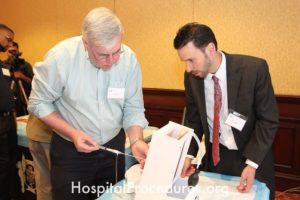A historical myth in procedural medicine is the operator should limit removal of pleural fluid to 1.5 L during thoracentesis because of the risk of re-expansion pulmonary edema or pneumothorax. New evidence supports safety of large volume thoracentesis until no fluid remains. The two big concerns with a large volume thoracentesis are the risks of pneumothorax ex vacuo and re-expansion pulmonary edema (REPE). Due to these concerns, the historical teaching has been to limit the volume of pleural fluid removed. Initially, the volume that was “safe” to remove with thoracentesis was 1 liter and was later increased to 1.5 L and some new guidelines are suggesting 1.8 L as a “safe” volume. These are truly arbitrary numbers, but the real question is whether you can safely remove more fluid without increasing the risk of REPE and pneumothorax ex vacuo?
In his landmark study of over 9,300 thoracenteses at Cedars-Sinai medical center, Mark Ault, M.D. performed 799 thoracenteses with removal of >1,500 mL pleural fluid. Pleural effusions were drained dry unless the patient started to develop worsening central chest pressure or if the operator detected a subjective sensation of increased negative intrapleural pressure. Note that pleural manometry was not used with any of these patients. Basically, if resistance was felt during manual aspiration of pleural fluid the procedure was stopped. Six patients of these 799 thoracenteses developed REPE for an incidence of 0.75%. However, many thoracenteses of up to 3.5 L of pleural fluid were performed without complications in this study.1
Other investigators recommend performing pleural manometry during every large volume thoracentesis to prevent REPE. They have suggested that volume can be removed as long as the intrapleural pressure is not less than -20 cmH2O. A recent trial of 124 patients compared pleural manometry vs standard manual aspiration. Pleural manometry did not reduce any complications or patient-centered outcomes.2
Finally, the recent GRAVIAS trial demonstrated that manual aspiration is as safe as gravity drainage for therapeutic thoracentesis. It was a prospective, multi-center RCT of 142 patients that compared manual aspiration with gravity drainage of pleural effusions. Both active aspiration and gravity drainage had a similar rate of complications and subjective patient discomfort.3
In summary, it appears safe to perform large volume thoracentesis until the pleural space is dry without pleural manometry unless:
- Patient develops persistent central chest pressure
- Subjective sensation of increased negative pleural pressure (resistance with manual aspiration)
- +/- intractable coughing with dyspnea (some coughing is normal as the collapsed lung expands). Protracted coughing with dyspnea with aspiration on hold is not normal and should probably stop the procedure

Sources:
